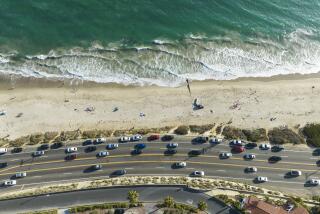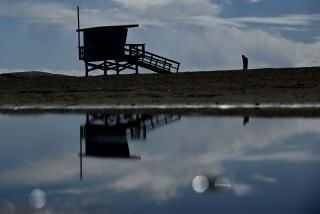Sydney’s Surf Fouled by Flow of Sewage
SYDNEY, Australia — While most Americans shiver through winter, Australians are flocking to the beach to enjoy the Southern Hemisphere summer. But they’re wary about cooling off in the polluted Sydney surf.
Not far beyond the breakers, sewage outlets pump 208 million gallons of effluent a year into the shallow blue South Pacific.
Gobs of grease, disposable diapers, bacteria and other pollutants are fouling the water and washing up on the sand. The local government is trying to clean up a 37-mile stretch of coastline.
“We wouldn’t be spending $292 million unless we had a problem,” Sandy Thomas, a spokesman for the city’s Water Board, said in an interview.
Daily Pollution Reports
Thomas heads an organization called Surfline, which monitors beach pollution and issues daily advisories for Sydney’s 40 beaches. Since it was set up a year ago, Surfline has received an average of 1,300 calls a week from people asking if it is safe to swim, Thomas said.
“There have been 30 episodes this summer when we’ve advised people not to swim on an individual beach,” he said. “But it’s not as if the whole coast gets wiped out in a big hit.”
All of the sewage, but little industrial waste, from this city of 3.3 million flows into the sea after being treated.
The Water Board is spending $198 million to build three long pipelines to carry the sewage farther out to sea. When completed, they will release the effluent 2.4 miles off the coast into water 265 feet deep. The board has also allotted $94 million to upgrade treatment and recycling. Its television campaign says: “We’re spending millions--and there will be nothing to show for it.”
‘A Major Problem’
“We’re working as hard and as fast as we can to control the situation,” Keith Bashford of Surfline said. “It’s obviously a major problem.”
The Water Board has asked Sydney residents not to dispose of oils and fats down kitchen drains and not to flush disposable diapers down toilets.
The panel said that its coastal sewage treatment plants receive an average of 65 tons of fats, oils and assorted grease a day, much of which ends up in balls on the beaches because of its resistance to treatment.
“We advise people against swimming when the water is murky from grease, has a strong odor or elevated bacteria counts,” Thomas said. “It’s not a major health problem. Ear, nose and throat infections are the most common problems.”
Cleaner Than Others
Bashford said that despite the problem, Sydney’s beaches are cleaner than those in many parts of the world, mentioning southern Europe’s polluted Mediterranean shores. But he said that local standards are high and rising.
“There’s been a revolution in the past couple of years,” Thomas said. “People are more aware. It has a political effect, so the politicians respond.”
More to Read
Sign up for Essential California
The most important California stories and recommendations in your inbox every morning.
You may occasionally receive promotional content from the Los Angeles Times.










